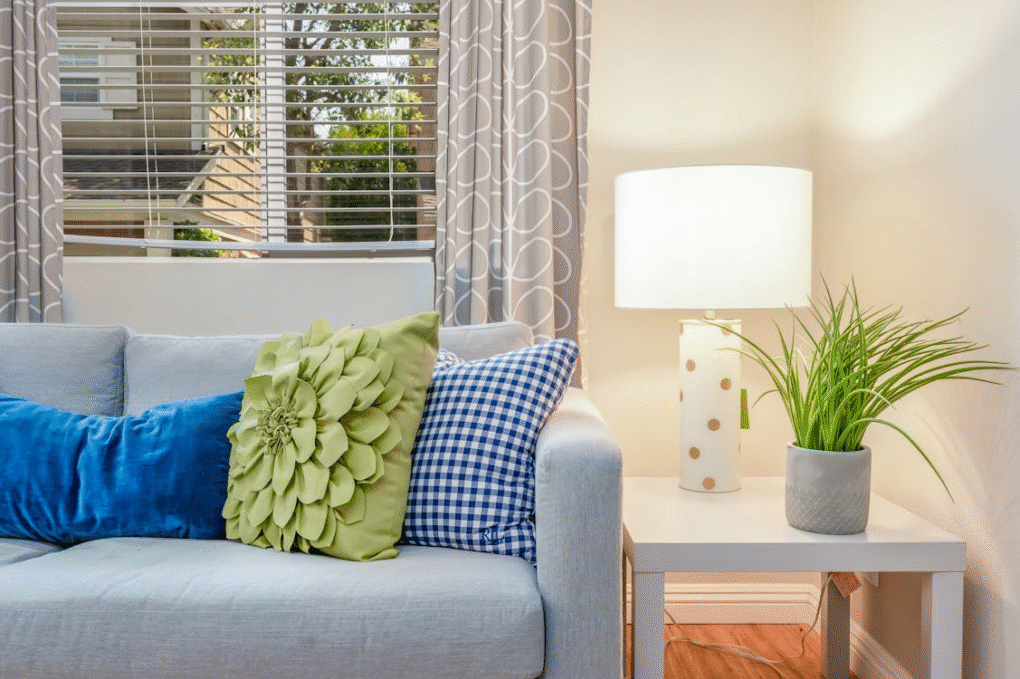
Design flow in interior design is all about how one room connects to the next—visually, emotionally, and practically. It’s the smooth, natural sensation that every space belongs within the same home.
A cohesive look doesn’t mean every room has to match, but everything should work together in harmony. When done right, it creates comfort, improves function, and makes your home feel more thoughtful and inviting.
Using consistent colours, textures, and repeated materials ties your entire space together. Let’s explore how to bring that harmony into every corner of your home.
Grounding Your Spaces: The Power of Rugs in Visual Continuity
Rugs do more than just warm up a room—they help ground your space and create visual flow, especially in open floor plans.
In homes where one area seamlessly blends into the next, rugs define each zone without the need for walls. A soft rug under a dining table or a textured one in a reading nook helps tell your home’s story clearly, one area at a time.
When you want a cohesive look, texture plays a significant role. Choosing similar textures or natural materials across rooms can tie everything together without it feeling too uniform. The Rug.com.au range of jute rugs excels in providing this effect.
Jute rugs offer an earthy, woven texture that works with almost any style—from coastal to modern to farmhouse. They’re neutral enough to blend in but rich in texture to make each space feel grounded.
These rugs also provide a natural touch that unifies spaces, whether you’re working with hardwood, tile, or carpet. Plus, they’re durable, stylish, and versatile. If you’re looking to enhance the flow of your home, starting with the right rug is one of the simplest and most effective strategies.
Colour Palette Consistency: Choosing Tones That Travel
Choosing a colour scheme that flows throughout your home starts with a solid palette—ideally three to five colours. Select a dominant tone for walls and large furnishings (around 60%), such as calming neutrals like white, beige, or soft grey, to serve as the foundation.
Then add a secondary hue (25–30%) for cabinets, soft furnishings, or rugs, followed by a bold accent (5–10%) for accessories. This approach follows the classic 60 30 10 rule that keeps spaces balanced and visually connected.
Use accent colours to subtly tie rooms together. Repeating a consistent shade across spaces helps maintain cohesion without it becoming repetitive. For instance, if your living room features deep blue accents, echo that same blue in the bedroom’s artwork or cushions.
Neutrals act as visual glue, creating smooth transitions between rooms. Layering in richer hues—such as a muted olive in one space or calming sage in another—adds personality while preserving harmony.
With these strategies—consistent base colours, shared accents, and balanced contrasts—you can create a seamless design flow that feels connected and uniquely lived-in.
Repeating Materials and Finishes for Visual Rhythm
Repeating materials and finishes create a visual rhythm that guides the eye and brings your home together. It’s about echoing tones, textures, and styles so that each space feels intentional and linked.
Start by selecting a few key materials—similar wood tones, metals, or fabrics—and use them consistently. For example, matching door hardware across rooms or repeating brushed brass in lighting and cabinet handles provides a subtle yet powerful sense of unity.
Textures also matter—for example, a natural wood table in the dining room, mirrored by wooden frames or woven baskets in the living area, adds warmth and cohesion. Soft fabrics, such as linen curtains and velvet cushions, carry a comforting softness from room to room.
This visual rhythm keeps your home feeling thoughtfully designed. Instead of jarring transitions, there’s a gentle beat to your décor—like a melody connecting each room without repeating the same verse. The result? A space that feels harmonious, personal, and beautifully orchestrated.
Furniture Styles and Placement: Keeping the Language Uniform
When furniture styles and placement align across rooms, your home feels intentional, not disjointed. Start by choosing complementary pieces. For example, a mid century modern sofa in the living room can pair with similarly styled chairs in the dining room, creating a subtle thread between areas.
Avoid mixing clashing styles in adjoining rooms. Stick to one design language—whether modern, transitional, or vintage—so your spaces feel cohesive. A touch of contrast adds interest, but maintaining balance between styles is key.
Placement matters too. Align key pieces like sofas, beds, and tables parallel to walls and walkways, leaving 45–90 cm of clear space around them. This ensures movement is easy and natural from one room to the next.
Let the layout guide movement. For example, placing a console behind a sofa can define zones without walls, while facing seating toward an adjacent space fosters connection. With repeated styles and considered placement, each room maintains its character while contributing to a greater, unified story.
Lighting Strategy That Guides the Eye
Lighting isn’t just about brightness—it’s your home’s visual guide. The key? Layered lighting. Begin with ambient light (overhead fixtures) for general illumination. Then add task lighting, such as desk or reading lamps, for function. Finally, incorporate accent lighting to highlight artwork or architectural details.
In open or adjoining spaces, coordinating fixtures helps maintain a harmonious look. Choose similar metal finishes or consistent bulb temperatures to prevent visual clashes and ensure smooth transitions from room to room.
Choose fixtures that reflect your home’s overall style—such as sleek pendants in the kitchen and soft sconces in the hallway. Repeat signature elements like finishes or shapes throughout to maintain cohesion.
Dimmer switches are a small but powerful tool that can shift mood easily—from bright and energising during the day to soft and cosy at night. Through deliberate layering, consistency, and style alignment, lighting can unify your home, guiding the eye and setting the tone.
A Home That Flows Feels Better to Live In
Design flow isn’t just about style—it’s about how your home feels. When colours, textures, furniture, and lighting connect from room to room, your space becomes more peaceful, more functional, and more inviting. With a few thoughtful choices, you can transform your home into a beautifully unified space.
